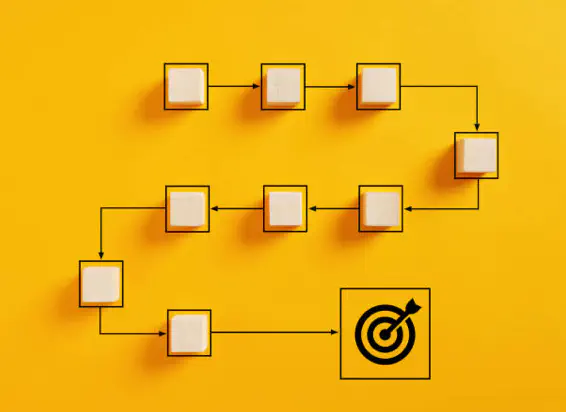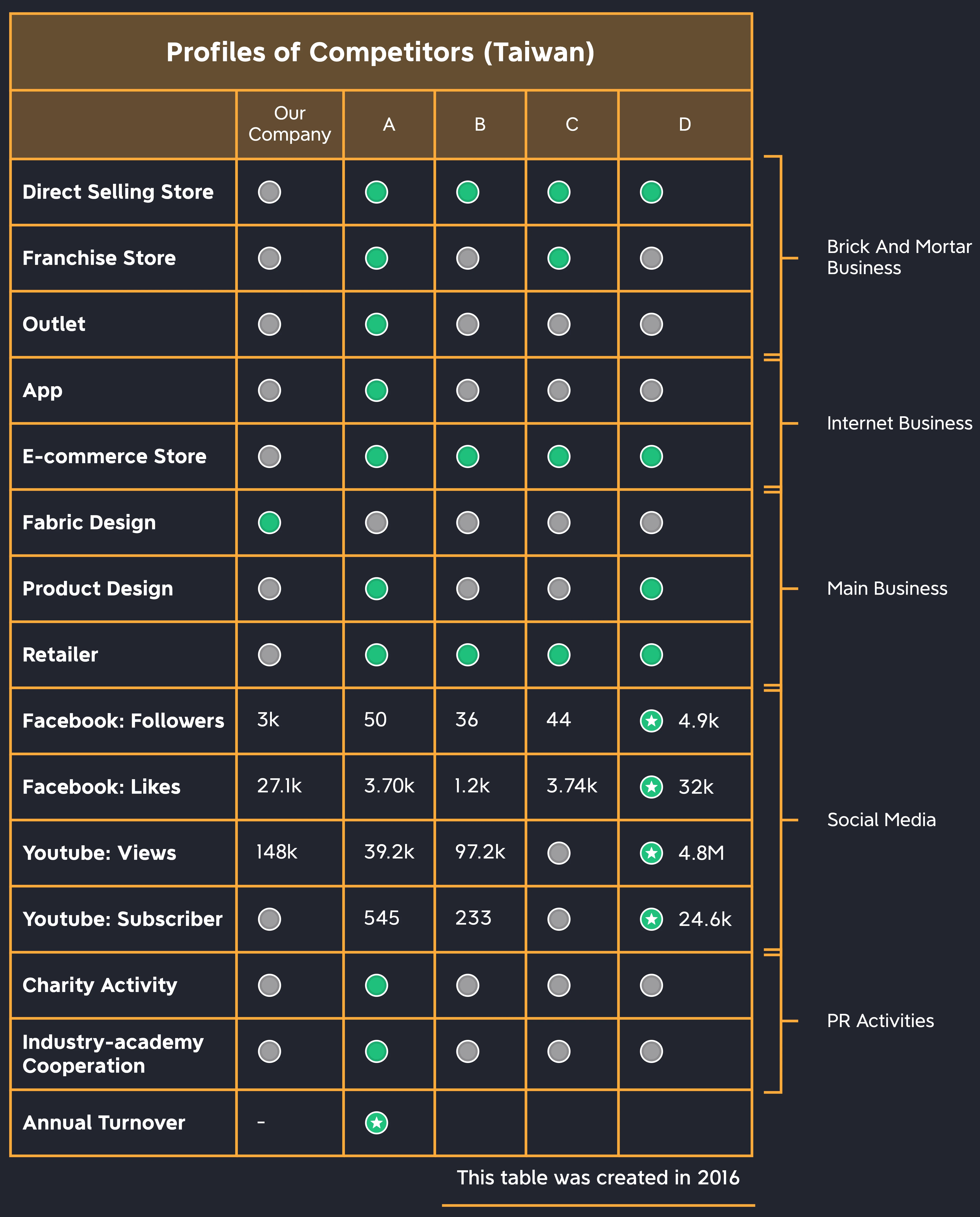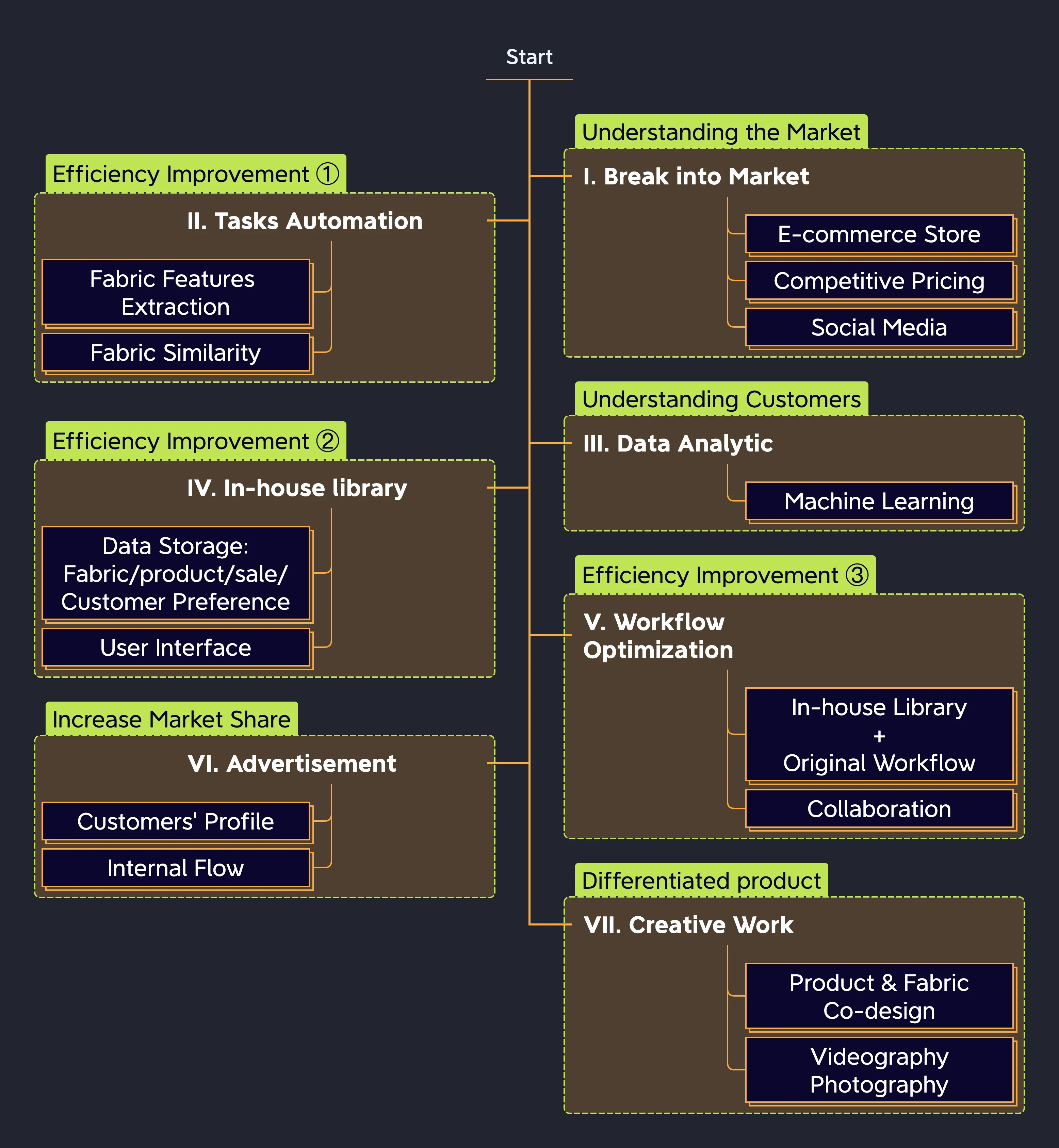Transitions toward B2C E-commerce: Part II
 Photo by Diggity Marketing on Unsplash
Photo by Diggity Marketing on Unsplash
Table of Contents
Abstract
This document presents a competitor analysis and a strategy and timeline for transitioning our business into B2C e-commerce.
To begin, we create a competitor profile that identifies social media and e-commerce as promising entry points. After investigating our competitors’ social media strategies, we have discovered that posting tutorial videos about bag making on Facebook is the most effective way to reach potential customers.
Next, we conduct a SWOT analysis to determine how we can utilize our strengths in fabric design and workflow automation to overcome weaknesses and threats from external competitors. We also note that our long-term goal is to create unique products as a differentiating factor.
Finally, we set up a logical and chronological timeline based on the aforementioned analysis, prioritizing the necessary actions.
1. Introduction
Competitor analysis (CA) is a cornerstone of market studies, providing meaningful insights and guiding actions. Firms that have a system to monitor their competitors also tend to show better profitability ( Citation: Subramanian & IsHak, 1998 Subramanian, R. & IsHak, S. (1998). Competitor analysis practices of US companies: An empirical investigation. MIR: Management International Review. 7–23. ) . This is particularly important for us, as our objective is to venture into a new business, as mentioned in the business transition plan.
A competitor analysis for a business may involve the following steps:
- Identify the business’s competitors and analyze their products, pricing, and sales.
- Identify the competitors’ marketing strategies.
- Use the findings to create benchmarks.
- Estimate market share and potential growth.
Thanks to the internet era, businesses can provide information about their products on the web or promote them via social media. This makes competitive analysis much easier since most of the necessary information can be found online. However, tasks such as retrieving information for all products from an online shop can be repetitive and time-consuming. To handle such tasks efficiently, we build a website crawler as described in the appendix.
2. Competitor Analysis
2.1. Profile and Benchmark
To gain an understanding of the market, we can begin by creating a profile of our competitors. Based on the results from the search engine and estimations, we have created a table as shown in Table. 1.(Due to confidentiality, some content in the table has been replaced by green and gray symbols.)
Observation
- All of our competitors have both direct selling and e-commerce stores.
- Competitors in Taiwan mainly focus on product design and retail operations.
- The companies, except for competitor D, have a weak social media presence, indicating that they have not utilized social media as a marketing tool for promotion.
- Competitor A has the highest annual turnover and a diverse range of businesses.
- Competitor D has the highest popularity on social media.
Action
- To enter the B2C business, the first step should be to promote our product on social media and e-commerce platforms. These areas have a low barrier of entry, and our competitors have not yet focused on them.
- We need to analyze the social media strategies of competitor D.
- For our long-term goals, we should leverage our advantage in fabric design and combine it with our knowledge of customer preferences gathered during E-commerce store operations. This will allow us to incorporate this information into our product design and create unique products.
Profile of our top four competitors in the market. (Due to confidentiality, some content in the table has been replaced by green and gray symbols.)

2.2. Post on Facebook
To study competitor D more thoroughly, we can use a website crawler to retrieve all of their posts on Facebook.
Observation
- The competitor D began promoting on Facebook in 2014, with an average of 40 posts per month. The average number of reactions per post gradually increased to 1000, as shown in Fig. 1(a).
- According to Fig. 1(b), ninety-eight percent of the content is made up of text and image posts. However, they use YouTube links instead of in-line videos within their posts.
Action
- To compete with our competitors, we should consider generating at least one post per day to match their performance of 40 posts per month.
- We can utilize video posts, which can generate 1200% more shares than text and image content combined. This has the potential to reach more people than our competitors’ posts.
Information regarding the Facebook posts of competitor D from Table 1, including: (a) The number of posts per month and the average number of reactions per post; (b) The proportion of image, text, and video posts.
(a)show hide
━━ Number of Reactions
(b)show hide
2.3. Video on YouTube
As competitor D redirected their audience to YouTube in their Facebook post, we can analyze the content on their channel. Just as a Facebook post can be extracted, a website crawler is also useful for retrieving video information on YouTube.
Observation
- The competitor’s channel has three main categories: sewing techniques, product promotion, and bag tutorials (see Fig. 2(a)(b)). Bag tutorials have the highest number of videos and contribute to around 62% of the total views.
- The video length is around 20 minutes, as shown in Fig. 2(c).
Action
- We might consider using a bag tutorial as a promotional tool due to its high popularity.
- We may consider reducing the video length to 20 minutes.
Content on the YouTube channel of competitor D from Table 1, including (a) the proportion of videos in each category, (b) the proportion of view counts for each category, and (c) distribution of video length.
(a)show hide
(b)show hide
(c)show hide
2.4. Product, Pricing, and Sales
Since this information is not publicly available, it is inappropriate to disclose details on how to retrieve it or any results obtained. However, we can share our general approach. We gather information on product and pricing from our competitors’ sales pages. We compare daily or monthly sales results to obtain sales data, which we then use to estimate market share and potential growth.
3. Strategy
Based on the findings from competitive analysis, we can plan our strategy by conducting a SWOT analysis first and then prioritizing actions accordingly.
3.1. SWOT Analysis

- Strength:
- We have plenty of experience in fabric design, which is beneficial for designing unique products in the long run. This is because we have fewer restrictions on fabric selection and usage.
- We are capable of automating our workflow with algorithms and machine learning (ML) techniques. This can lead to lower operating costs and a reduced workforce, making us more resilient when confronting difficult situations.
- Weakness:
- Currently, we lack experience in the consumer market. This can be overcome by utilizing data analytics, such as analyzing purchase history and social media activity.
- Designing a great product requires hard work and dedication. Collaborating with other designers and gaining experience along the way can help us get started on the right path.
- Opportunities:
- Short term: Our competitors have not yet focused on social media for product promotion, but this is only a short-term advantage. Eventually, they will also join the competition.
- Long term: Utilize our experience in fabric design and the customer preference information gathered from the e-commerce store to create a unique product that stands out from the competition.
- Threats:
- Short term: Selling a similar product on an e-commerce store may result in price competition. Larger corporations may use this as a weapon to eliminate other competitors because they have more resources to withstand short-term losses. With our strength in workflow automation and lower operational costs, we are better equipped to survive in this competition.
- Long term: Due to the lack of copyright protection in fabric and product design, competitors may replicate our designs. To address this issue, we can leverage our strength in workflow automation to accelerate design and release new products more frequently.
3.2. Milestones
Based on the results of the SWOT analysis, we can create a timeline for the necessary actions.

- I. Break into Market:
We will leverage social media opportunities and set up an e-commerce store. We will use competitive pricing to break into the market with the purpose of collecting enough feedback and sales data to understand the market. - II. Task Automation:
We have divided the efficiency improvement program into three steps. The first step is to automate daily routine work using algorithms. Specifically, we will focus on fabric feature extraction and retrieving similar fabrics, which are the preliminary steps for building an in-house library. This is also the most time-consuming task in daily work. - III. Data Analytic:
Once we have collected enough data from the e-commerce store, we will use machine learning techniques such as cluster analysis and regression to understand our customers’ preferences. - IV. In-house library:
By combining the results from task automation and data analytics, we will build a library that serves as a data storage system. This will enable team members to access and retrieve required data more efficiently. - V. Workflow Optimization:
We will integrate our in-house library with our original workflow and empasize on collaboration to further improving the efficiency. - VI. Advertisement:
Targeting potential customers with advertisements effectively requires customer profiles. Therefore, we have placed this action in the later phase of the timeline. Sufficient data from the e-commerce store is needed to create a customer profile. In addition, we should establish our internal advertising flow to avoid unclear and opaque processes offered by advertisers. - VII. Creative work:
After gaining enough experience through collaboration with other designers, we should focus on co-designing products and fabrics to create a differentiated product that will set us apart from our competitors.
4. Conclusion
This document outlines a strategy for transitioning our business model into B2C e-commerce.
First, we conduct a competitor analysis by creating a competitor profile. This reveals that social media and e-commerce are good entry points to the market. We then analyze our competitors’ social media promotion strategies and find that creating video tutorials about making bags is the best way to reach potential customers. Due to confidentiality, we can only briefly describe how we estimate our competitors’ sales.
Next, we perform a SWOT analysis. Our strengths lie in our experience in fabric design and our ability to automate workflows. This not only enables us to overcome short-term threats from price competition but also creates long-term opportunities to differentiate our products. To overcome our weakness in being unfamiliar with the consumer market, we plan to utilize short-term opportunities on social media. Regarding our weakness in product design, collaborating with other designers initially is a good way to gain experience.
Based on the aforementioned analysis, we have established a timeline. To break into the market, we will set up an e-commerce store and utilize competitive pricing and social media promotion. We will also use machine learning techniques to understand customer preferences.
For our efficiency improvement program, we’ve divided it into three parts. First, we’ll implement algorithms that focus on fabric feature extraction and retrieving similar fabrics. Next, we’ll build an in-house library to store data about fabrics, products, and sales, with a user interface that allows team members to access and retrieve required data more efficiently. Third, we’ll integrate our workflow with the in-house library, emphasizing collaboration.
Finally, we will increase our market share through advertising, which will be based on the customer profiles we build and our internal advertising flow.
Our long-term goal is to focus on fabric and product design to create unique products as a differentiating factor from our competitors.
5. Appendix: Website Crawlers
5.1. Program
Four major steps of the website crawler: target, login, search, and extract.

A website crawler can be implemented using Selenium in Python, which involves four major steps:
Target: Users can provide a list of URLs as targets.
Login: Users may be required to log in with credentials. For example, a user needs to enter their email and password to log in to Facebook and view its content.
Retrieve: Users can retrieve HTML elements by selector. The following code provides an example that uses Firefox as a browser and retrieves all elements with the tag name “article” in a given URL.
# Open browser
driver = selenium.webdriver.Firefox(options=options)
# Visit url
driver.get(url)
# Retrieve all element with tag name "article"
articles = driver.find_elements("tag name", "article")
Extract: Users can extract information from HTML elements. For example, for each article retrieved from the previous step, it is possible to extract the post’s ID from its attribute and take a screenshot of each element.
for article in articles:
data_ft = article.get_attribute("data-ft")
post_id = data_ft["post_id"]
article.screenshot(post_id + ".png")
...
For detailed implementation, please refer to the GitHub repository.
5.2. Performance
The website crawler can be used on any website composed of HTML elements. To demonstrate its performance, we use Facebook as an example and measure the number of posts retrieved over time, as shown in Fig. 4. Unlike the Meta Graph API, which has a limit of 600 posts per year, the crawler can retrieve more posts and organize them chronologically.
Number of posts retrieved from Facebook pages.
━━ Meta Graph API limit
Reference
- Subramanian & IsHak (1998)
- Subramanian, R. & IsHak, S. (1998). Competitor analysis practices of US companies: An empirical investigation. MIR: Management International Review. 7–23.